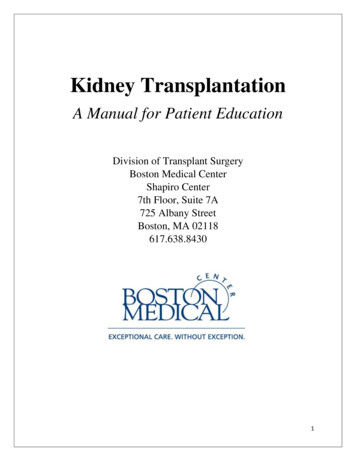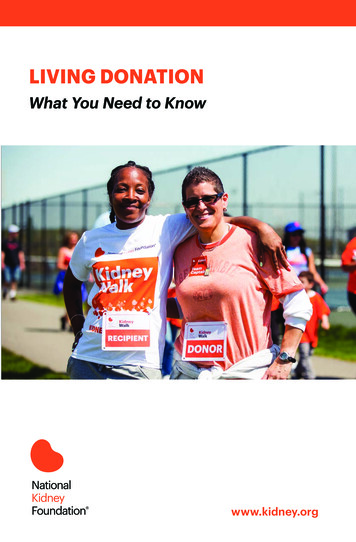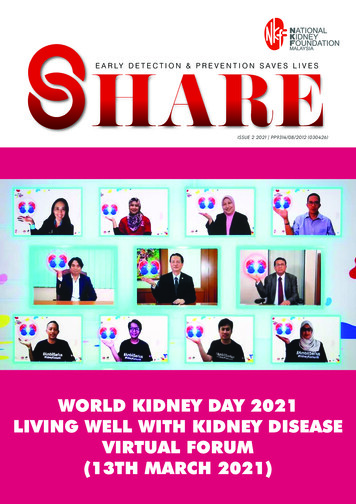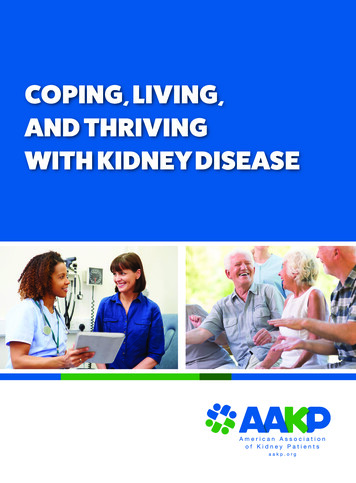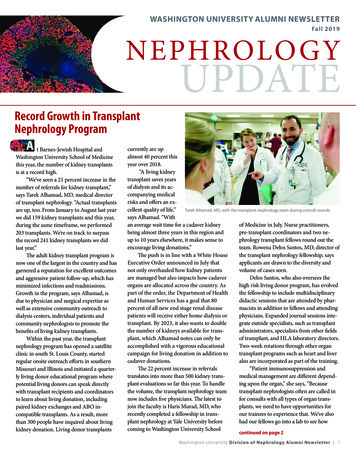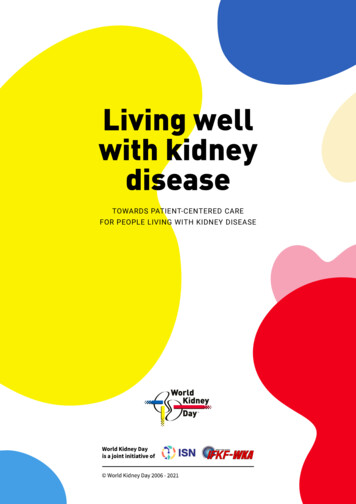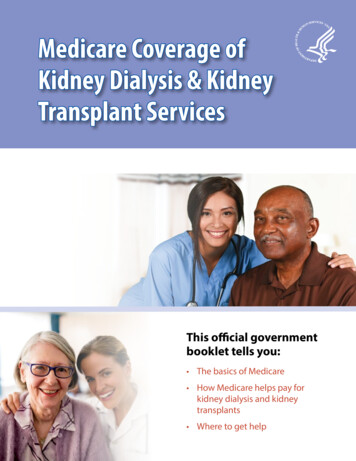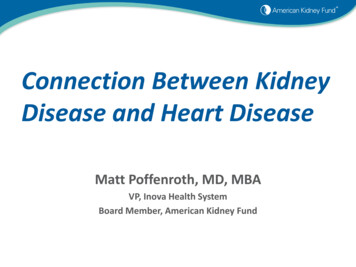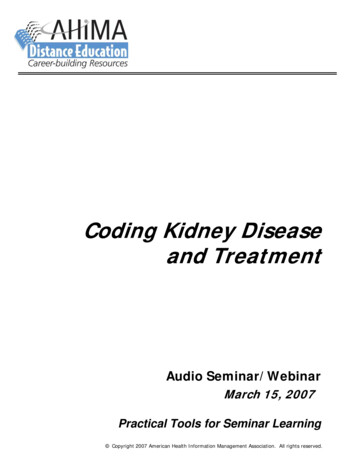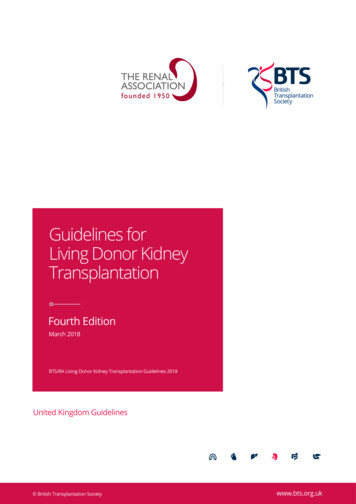
Transcription
Guidelines forLiving Donor KidneyTransplantationFourth EditionMarch 2018BTS/RA Living Donor Kidney Transplantation Guidelines 2018United Kingdom Guidelines British Transplantation Societywww.bts.org.uk
CONTENTS1INTRODUCTION AND Scope of the GuidelinesProcess of Writing and MethodologyEditorial CommitteeContributing AuthorsDisclaimerDeclarations of InterestGrading of RecommendationsAbbreviations56677101111122LEGAL FRAMEWORK152.12.22.32.42.52.62.72.82.92.10The Human Tissue Act 2004The Human Tissue Authority (HTA)The European Union Organ Donation DirectiveConsent for the Removal of Organs from Living DonorsTypes of Living Kidney Donation Permitted by the LegislationRequirements for Transplants involving a Living DonorProhibition of Commercial Dealings in Human MaterialReimbursement of ExpensesExceptional CircumstancesThe Human Tissue (Scotland) Act 63.73.8EthicsKey Ethical Principles in Living Donor TransplantationThe Recipient PerspectiveThe Donor PerspectiveThe Transplant Team PerspectiveExpanding the Living Donor PoolThe Child or Young Person as a Living DonorThe British Transplantation Society (BTS) Ethics Committee26262728293030304SUPPORTING AND INFORMING THE POTENTIAL rming the Potential DonorInformed Consent for Living Kidney DonationDonor IdentityPatient AdvocacyIndependent TranslatorsPsychological IssuesDeath and Transplant Failure33343539404242455DONOR EVALUATION485.15.25.35.45.5IntroductionDonor Evaluation: SummaryABO Blood Grouping and Crossmatch TestingMedical AssessmentAssessment of Renal Function4852585966BTS/RA Living Donor Kidney Transplantation Guidelines 20182
nor AgeDonor ObesityHypertension in the DonorDiabetes MellitusCardiovascular EvaluationProteinuriaNon-Visible HaematuriaPyuriaInfection in the Prospective DonorNephrolithiasisHaematological DiseaseFamilial Renal DiseaseDonor ERY: TECHNICAL ASPECTS, DONOR RISK ANDPERI-OPERATIVE CARE1716.16.26.36.46.56.66.7IntroductionAssessment of Renal AnatomyPeri-Operative MortalityPeri-Operative MorbidityLong-Term MortalityPre-operative Care and PreparationDonor Y TESTING FOR LIVING DONORKIDNEY TRANSPLANTATION1917.17.27.37.47.5Assessment of Donor-Recipient HLA Mismatch StatusIdentification and Characterisation of AlloantibodiesPre-transplant Donor-Recipient Crossmatch TestSelection of Suitable Donor-Recipient PairsAntibody Incompatible Living Donor Transplantation1931941961981998EXPANDING THE DONOR POOL2028.18.28.38.4Paired/Pooled Living DonationAltruistic Donation (Directed and Non-directed)Antibody Incompatible DonationAppendix: Mental Health Assessment of Altruistic Kidney Donors2032102192229LOGISTICAL CONSIDERATIONS2359.19.29.39.4Reimbursement of Living Donor ExpensesDonors who are Non-UK ResidentsPrisoners as Living DonorsAppendix: Template Letter for Potential Overseas Donors23523723824310DONOR FOLLOW-UP AND LONG-TERM OUTCOME24710.110.210.310.4Long-Term Outcome Following Living Kidney DonationArrangements for Follow-upThe Unsuitable DonorPregnancy following Kidney Donation248251255256BTS/RA Living Donor Kidney Transplantation Guidelines 20183
11RECIPIENT OUTCOME AFTER LIVING DONOR KIDNEYTRANSPLANTATION IN ADULTS26011.111.211.311.4Living versus Deceased Donor TransplantationExtended Criteria Living DonorsTransplantation versus DialysisHigh Risk Recipients26126126226312RECURRENT RENAL 012.1112.1212.1312.14IntroductionDiabetic NephropathyPrimary Focal Segmental GlomerulosclerosisIgA NephropathyMembranous NephropathyAmyloidosisSystemic Lupus ErythematosusANCA Associated Systemic VasculitisGoodpasture’s DiseaseAlport SyndromeMesangiocapillary GlomerulonephritisHaemolytic Uraemic SyndromePrimary 27427527727827913LIVING DONOR KIDNEY TRANSPLANTATION IN CHILDREN28413.113.213.313.4IntroductionDonor SelectionRecipient 14.2Conflicts of InterestSearch Strategies291292BTS/RA Living Donor Kidney Transplantation Guidelines 20184
1INTRODUCTION AND OBJECTIVES1.1IntroductionKidney transplantation from a living donor, when available, is the treatment of choicefor most patients with end stage renal disease, offering optimum patient and graftsurvival and reduced time on the national transplant waiting list. Living donortransplantation also offers a proportion of complex recipients the opportunity tobenefit from a transplant that they might otherwise not have received from thedeceased donor waiting list; or, through the UK Living Kidney Sharing Schemes(UKLKSS), a better quality or better matched kidney than might otherwise have beenavailable.For all these reasons, and the opportunity to expand the kidney donor pool, livingkidney donation has been actively promoted in the UK over the last 20 years. At thetime of writing, approximately 1 in 3 kidney transplants performed in the UK are fromliving donors. The latest national statistics show that there were 998 living kidneydonor transplants in the UK in 2016-17 (1). Of 926 adult donor transplants, 484 wererelated, 442 were unrelated, 18 were HLA incompatible, 65 were ABO incompatible,109 were paired/pooled, and 81 were altruistic donor transplants. 36% of thepatients transplanted from living donors were transplanted pre-emptively,i.e. without a need for dialysis (1).The expansion of the UKLKSS has represented a significant change in practicesince the last edition of this guideline, not least by reducing the need for HLA- andABO-incompatible transplantation. In parallel, increasing confidence in the safety ofliving kidney donation has permitted the expansion of the potential donor pool; todate, the oldest living kidney donor in the UK was aged 85.Nonetheless, it must be recognised that living kidney donation carries some risk.The welfare of the donor remains paramount, and vigilance in donor care andmanagement is essential to ensure that appropriate safeguards are in place toprotect individuals and to inspire public confidence. These guidelines are intendedto act as a resource for the transplant community, and to underpin best practice inliving donor kidney transplantation.BTS/RA Living Donor Kidney Transplantation Guidelines 20185
1.2Scope of the GuidelinesThis guidance relates only to living donor kidney transplantation and reflects agrowing body of evidence, incorporating aspects of clinical practice that are relevantto both adult and paediatric settings. These include the ethical and medico-legalaspects of donor selection, medical and pre-operative donor evaluation,identification of high risk donors, the management of complications, and expectedoutcome. Scenarios that present an increased level of risk to the potential n,recurrentdiseaseandtransplantation in the context of other co-morbidities, are also included. Guidance isprovided on the most appropriate investigations to be considered to assist clinicaldecision-making, and the best surgical approaches when faced with different clinicalscenarios.1.3Process of Writing and MethodologyThe original ‘UK Guidelines for Living Donor Kidney Transplantation’ werecommissioned by the British Transplantation Society (BTS) and the RenalAssociation (RA) as part of a wider initiative to develop ‘Best Practice’ guidance forclinicians involved in transplantation. Initially published in 2000 (2) and revised in2005 (3) and 2011 (4), the guidelines have achieved international repute. This fourthedition has used the framework of previous editions but has been significantlyupdated in the light of new data and changing practice. It has been produced withwide representation from UK colleagues and professional bodies involved in bothdonor and recipient management and in consultation with patient representatives.In updating these guidelines, areas of interest were identified with input fromclinicians and patient representatives. A systematic review of the relevant literatureand synthesis of the available evidence was undertaken by selected relevant clinicalexperts. This was followed by peer group appraisal and expert review. Draftproposals were amended by the editorial committee and the appropriate levels ofevidence added to recommendations. Wider consultation with the transplantcommunity was undertaken by e-mail. The penultimate draft of the document wasplaced on the BTS website in January 2018 for a six week period of openconsultation, to which professional groups, patients and other authorities wereactively encouraged to contribute. The final document was posted in March 2018.BTS/RA Living Donor Kidney Transplantation Guidelines 20186
Where available, these guidelines are based on published evidence, and theevidence and recommendations have been graded for strength except where thepublished studies are descriptive. With a handful of exceptions, conferencepresentations have not been included and the publication cut-off date for evidencewas July 2017.It is anticipated that these guidelines will next be revised in 2023.1.4Editorial CommitteeDr Peter A Andrews MD FRCPConsultant Nephrologist & Clinical Lead for Transplantation, SW Thames Renal &Transplantation Unit, St Helier Hospital, SurreyReader in Renal Medicine, University of LondonChair of BTS Standards CommitteeMs Lisa Burnapp RN MAConsultant Nurse, Living Donor Kidney Transplantation, Guy’s & St Thomas’ NHSFoundation Trust, LondonLead Nurse - Living Donation, Organ Donation and Transplantation, NHS Blood andTransplant (NHSBT)1.5Contributing AuthorsDr Peter Andrews MD FRCP, Consultant Nephrologist & Reader in Renal Medicine,SW Thames Renal & Transplantation Unit, St Helier Hospital, SurreyDr Richard Baker PhD FRCP, Consultant Nephrologist, St. James’s UniversityHospital, LeedsProf Simon Ball PhD FRCP, Consultant Nephrologist, Queen Elizabeth Hospital,BirminghamDr Kate Bramham PhD MRCP, Consultant Nephrologist, King’s College Hospital,LondonMr Tim Brown FRCS, Consultant Transplant Surgeon, Belfast City Hospital, Belfast.BTS/RA Living Donor Kidney Transplantation Guidelines 20187
Ms Lisa Burnapp RN MA, Lead Nurse, Living Donation, NHS Blood and Transplant& Consultant Nurse, Living Donor Kidney Transplantation, Guy’s & St Thomas’NHS Foundation Trust, LondonProf Jamie Cavenagh MD FRCP FRCPath, Consultant Haematologist, Barts andthe London NHS Trust, LondonMr Marc Clancy PhD FRCS, Consultant Transplant Surgeon, Queen ElizabethHospital, GlasgowDr Aisling Courtney MPhil FRCP, Consultant Nephrologist, Belfast City Hospital,BelfastDr Sam Dutta, MS FRCS, Consultant Transplant Surgeon, Nottingham CityHospital, NottinghamDr Robert Elias MD FRCP, Consultant Nephrologist, King’s College Hospital NHSFoundation Trust, LondonDr Anthony Fenton MRCP, Speciality Registrar, Queen Elizabeth Hospital,BirminghamProf Susan Fuggle DPhil FRCPath, Consultant Clinical Scientist, Oxford TransplantCentre, OxfordMr Keith Graetz DM FRCS, Consultant Transplant and General Surgeon,Wessex Kidney Centre, PortsmouthDr Siân Griffin PhD FRCP, Consultant Nephrologist, University Hospital of Wales,CardiffDr Brendan Healy MRCP MRCPath, Consultant in Microbiology and InfectiousDiseases, University Hospital of Wales, CardiffDr Rachel Hilton PhD FRCP, Consultant Nephrologist, Guy’s & St Thomas’ NHSFoundation Trust, LondonDr Gareth Jones PhD FRCP, Consultant Nephrologist, Royal Free Hospital, LondonDr Graham Lipkin MD FRCP, Consultant Nephrologist, University HospitalsBirmingham NHS Foundation Trust, BirminghamDr Adam Mclean DPhil FRCP, Consultant Nephrologist & Transplant Physician,West London Renal & Transplant Centre, LondonProf Nizam Mamode MD FRCS, Professor of Transplant Surgery, Guy’s & StThomas’ NHS Foundation Trust, LondonMs Hanna Maple PhD MRCS, SpR in Transplant Surgery, Guy’s & St Thomas’ NHSFoundation Trust, LondonDr Stephen Marks MRCP FRCPCH, Reader and Consultant in PaediatricNephrology, Great Ormond Street Hospital for Children NHS Foundation Trust,LondonBTS/RA Living Donor Kidney Transplantation Guidelines 20188
Dr Emma K Montgomery MRCP, Consultant Nephrologist, Freeman Hospital,NewcastleDr Peter Nightingale PhD, Statistician, University Hospitals Birmingham NHSFoundation Trust, BirminghamMr Jonathan Olsburgh PhD FRCS(Urol), Consultant Transplant & UrologicalSurgeon, Guy’s & St Thomas’ NHS Foundation Trust, LondonProfessor Michael Peters MD FMedSci, Professor of Applied Physiology, Brightonand Sussex Medical School, BrightonDr Michael Picton PhD FRCP, Consultant Nephrologist, Manchester RoyalInfirmary, ManchesterDr Stephen Potts FRCPsych FRCPE, Consultant in Transplant Psychiatry, RoyalInfirmary of Edinburgh, EdinburghDr Nicola Price DPhil FRCPath, Consultant Virologist, University Hospital of Wales,CardiffDr Richard Sandford PhD FRCP, Honorary Consultant in Medical Genetics,University of Cambridge, CambridgeDr Alastair Santhouse FRCP FRCPsych, Consultant Psychiatrist in PsychologicalMedicine, South London and Maudsley NHS Foundation Trust, LondonProf Neil Sheerin PhD MRCP, Professor of Nephrology, Newcastle University,NewcastleMs Lisa Silas RN MSc, Advanced Nurse Practitioner, Living Kidney Donation, ABOand Recipient Workup, Guy’s & St Thomas’ NHS foundation Trust, LondonMs Karen Stevenson PhD FRCS, Consultant Transplant Surgeon, Queen ElizabethHospital, GlasgowDr Craig Taylor PhD FRCPath, Director of Histocompatibility and Immunogenetics,Cambridge University Hospital NHS Foundation Trust, CambridgeDr Raj Thuraisingham MD FRCP, Consultant Nephrologist, Barts and the LondonNHS Trust, LondonDr Nicholas Torpey PhD FRCP, Consultant Nephrologist, Addenbrooke’s Hospital,CambridgeDr Caroline Wroe, Consultant Nephrologist, PhD MRCP, South Tees Hospitals NHSFoundation Trust, MiddlesboroughContributions to draft versions of this guideline were also made by the following:Prof Derek Manas, Professor of Transplant Surgery, NewcastleDr Liset Pengel, Peter Morris Centre for Evidence in Transplantation, LondonBTS/RA Living Donor Kidney Transplantation Guidelines 20189
Dr Mysore Phanish, Consultant Nephrologist, St Helier Hospital, SurreyMs Jan Shorrock, donor representative, ‘Give a Kidney’ charityThe following made helpful comments at the consultation stage which have beenincorporated into the final version of the guidelines:Prof Paul Cockwell, Consultant Nephrologist, Queen Elizabeth Hospital,BirminghamProf Colin Geddes, Consultant Nephrologist, Queen Elizabeth University Hospital,GlasgowMs Tess Harris, Chief Executive Officer, Polycystic Kidney Disease CharityMs Jessica Porter, Head of Regulation, on behalf of the Human Tissue Authority,LondonDr Kerry Tomlinson, Consultant Nephrologist, Royal Stoke University Hospital,Stoke-on-TrentMr Ray Trevitt, Living Donor Coordinator, Barts and the London NHS Trust, LondonProf Chris Watson, Professor of Transplant Surgery, Addenbrooke’s Hospital,CambridgeWe also thank contributors to earlier editions of this guideline, some of whose workremains unchanged in this edition, but who have been previously acknowledged.1.6DisclaimerThis document provides a guide to best practice, which inevitably evolves over time.All practitioners need to undertake clinical care on an individualised basis and keepup to date with changes in the practice of clinical medicine.These guidelines represent the collective opinions of a number of experts in the fieldand do not have the force of law. They contain information/guidance for use bypractitioners as a best practice tool. The opinions presented are subject to changeand should not be used in isolation to define the management for any individualpatient. The guidelines are not designed to be prescriptive, nor to define a standardof care.The British Transplantation Society and the Renal Association cannot attest to theBTS/RA Living Donor Kidney Transplantation Guidelines 201810
accuracy, completeness or currency of the opinions contained herein and do notaccept any responsibility or liability for any loss or damage caused toany practitioner or third party as a result of any reliance being placed on theguidelines or as a result of any inaccurate or misleading opinion contained therein.1.7Declarations of InterestEditors, authors and contributors have worked to the standards detailed in the BTSClinical Practice Guideline accessible urrent/Member/Clinical/CurrentGuidelines.aspx (7).Declarations of interest are listed in an appendix to this document.1.8Grading of RecommendationsIn these guidelines, the GRADE system has been used to rate the quality ofevidence and the strength of recommendations (4). This approach is consistent withthat adopted by KDIGO in its recent guidance relating to renal transplantation, andalso with guidelines from the European Best Practice Committee, and from theRenal Association.For each recommendation the quality of evidence has been graded as one of:A(high)B(moderate)C(low)D(very low)For each recommendation, the strength of recommendation has been indicated asone of:Level 1(we recommend)Level 2(we suggest)Not graded(where there is not enough evidence to allow formal grading)BTS/RA Living Donor Kidney Transplantation Guidelines 201811
These guidelines represent consensus opinion from experts in the field oftransplantation in the United Kingdom. They represent a snapshot of the evidenceavailable at the time of writing. It is recognised that recommendations are madeeven when the evidence is weak. It is felt that this is helpful to clinicians in dailypractice and is similar to the approach adopted by KDIGO (5).1.9AbbreviationsThe following abbreviations are used in this document:ABPMAmbulatory Blood Pressure MonitoringABOiABO IncompatibleACRAlbumin: Creatinine ratioADPKDAutosomal Dominant Polycystic Kidney DiseaseAITAntibody Incompatible TransplantationADCAltruistic Donor ChainAMLAngiomyolipomaBMIBody Mass IndexBTSBritish Transplantation SocietyCKDChronic Kidney DiseaseCMVCytomegalovirusCTSCollaborative Transplant StudyDADDirected Altruistic DonorDDDDense Deposit DiseaseDSADonor-Specific antibodyDTTDithiothreitolDVTDeep Vein ThrombosisEBVEpstein-Barr ViruseGFREstimated Glomerular Filtration RateESRDEnd Stage Renal DiseaseEUODDEuropean Union Organ Donation DirectiveECDExpanded Criterion DonorERASEnhanced Recovery After SurgeryFSGSFocal Segmental GlomerulosclerosisGMCGeneral Medical CouncilGFRGlomerular Filtration RateBTS/RA Living Donor Kidney Transplantation Guidelines 201812
HBVHepatitis B VirusHCVHepatitis C VirusHEVHepatitis E VirusHIVHuman Immunodeficiency VirusHLAHuman Leucocyte AntigenHLAiHLA Antibody IncompatibleHTAHuman Tissue AuthorityHTLVHuman T Lymphotrophic VirusHUSHaemolytic Uraemic SyndromeIAIndependent AssessorIFGImpaired Fasting GlucoseKDIGOKidney Disease: Improving Global OutcomesLDLiving DonorLDCLiving Donor Co-ordinatorLDKMRLiving Donor Kidney Matching RunLDKTLiving Donor Kidney TransplantationMCGNMesangiocapillary GlomerulonephritisMDTMulti-Disciplinary TeammGFRMeasured Glomerular Filtration RateMETSMetabolic EquivalentsMDSMyelodysplastic SyndromeMGUSMonoclonal Gammopathy of Uncertain SignificanceNDADNon-Directed Altruistic DonorNHSBTNHS Blood and TransplantNICENational Institute for Health and Care ExcellenceNTNTNon-Transfusion Dependent ThalassaemiaODTDirectorate of Organ Donation and TransplantationOGTTOral Glucose Tolerance TestPANVHPersistent Asymptomatic Non-Visible HaematuriaPCRProtein: Creatinine RatioPNVHPersistent Non-Visible HaematuriaPPDPaired/Pooled DonationRCCRenal Cell CarcinomaSaBTOAdvisory Committee on the Safety of Blood, Tissues and OrgansSCDStandard Criterion DonorSCTSickle Cell TraitBTS/RA Living Donor Kidney Transplantation Guidelines 201813
TBMNThin Basement Membrane NephropathyUKLKSSUK Living Kidney Sharing SchemesVTEVenous ThromboembolismReferences1. NHS Blood and Transplant. Annual report on living donor kidney 016 17.pdf2. British Transplantation Society / Renal Association. United Kingdom Guidelinesfor Living Donor Kidney Transplantation, 2000.3. British Transplantation Society / Renal Association. United Kingdom Guidelinesfor Living Donor Kidney Transplantation, Second Edition, 2005.4. British Transplantation Society / Renal Association. United Kingdom Guidelinesfor Living Donor Kidney Transplantation, Third Edition, ds-and-guidelines/5. Uhlig K, Macleod A, Craig J, et al. Grading evidence and recommendations forclinical practice guidelines in nephrology. A position statement from KidneyDisease: Improving Global Outcomes (KDIGO). Kidney Int 2006; 70: 2058-65.6. Kidney Disease Improving Global Outcomes (KDIGO) Transplant Work Group:KDIGO clinical practice guideline for the care of kidney transplant recipients. AmJ Transplant 2009; 9(S3): S1-S157.BTS/RA Living Donor Kidney Transplantation Guidelines 201814
2LEGAL FRAMEWORKRecommendations All transplants performed from living donors must comply with therequirements of the primary legislation (Human Tissue Act 2004 andHuman Tissue (Scotland) Act 2006), which regulate transplantation andorgan donation across the United Kingdom. (Not graded) All transplant centres performing living organ donation must belicensed by the Human Tissue Authority in line with the requirementsof the European Union Organ Donation Directive which sets out theminimum requirements for the Quality and Safety of Organs forTransplantation. (Not graded) Consent for the removal of organs from living donors, for the purposesof transplantation, must comply with the requirements of the HumanTissue Act 2004, and the Mental Capacity Act 2005 in England andWales, and the Mental Capacity Act 2016 in Northern Ireland. Consentin Scotland must comply with the Human Tissue (Scotland) Act 2006and the Adults with Incapacity (Scotland) Act 2000. (Not graded)The Human Tissue Act 2004 is the primary legislation regulating transplantation inEngland, Wales and Northern Ireland (1). Separate legislation, the Human Tissue(Scotland) Act 2006, applies in Scotland (2).2.1The Human Tissue Act 2004The Human Tissue Act (2004) sets out the licensing and legal framework for thestorage and use of human organs and tissue (excluding gametes and embryos) fromthe living and for the removal, storage and use of human organs and tissue from thedeceased. It permits authorised activities to be carried out for certain scheduledpurposes. The Act covers seven scheduled purposes requiring general consent, oneof which is transplantation, and this incorporates living donor transplantation (3).BTS/RA Living Donor Kidney Transplantation Guidelines 201815
Authorised activities, including transplantation, are only lawful if done with‘appropriate consent’ (4). Unauthorised dealings may result in offences, which carrypenalties (5). The Human Tissue Authority (HTA) issues Codes of practiceapplicable to those working in England, Wales and Northern Ireland, which establishguidelines for practice, particularly with regard to the meaning and extent of‘appropriate consent’ (6,7).2.2The Human Tissue Authority (HTA)The Human Tissue Authority (HTA) was established as the regulatory body underthe Human Tissue Act 2004 (8). The HTA regulates the removal, storage, and useof human bodies, organs and tissue from the deceased and the storage and use ofhuman organs and tissue (excluding gametes and embryos) from the living (9,10).The HTA is responsible for assessing all applications for organ donation from livingpeople. This involves an independent assessment process. All donors andrecipients see an Independent Assessor (IA) who is trained and accredited by theHTA and acts on behalf of the HTA to ensure that the donor has given valid consent,without duress or coercion, and that reward is not a factor in the donation. If the HTAis satisfied on these matters then approval for the living donation will be given. Clearguidance about the roles and responsibilities of the transplant team andIndependent Assessors in the context of living donation is published and regularlyupdated by the HTA (11).2.3The European Union Organ Donation DirectiveThe European Union Organ Donation Directive (EUODD) came into effect in August2012 (12). The EUODD was implemented to standardise systems and processesacross all member states to improve the quality and safety of human organsintended for transplantation. It is the first pan-European regulatory frameworkgoverning the donation and transplantation of organs from the living and deceasedand includes common standards for the procurement, transportation, traceability,characterisation and follow-up of living donors across the EU.BTS/RA Living Donor Kidney Transplantation Guidelines 201816
The HTA is the Competent Authority for the UK under the EUODD. Everytransplanting hospital is licensed by the HTA to perform specified activities relatedto the donation and/or implantation of a donated organ (13).2.4Consent for the Removal of Organs from Living DonorsSeeking consent for the removal of organs from living donors, for the purposes oftransplantation, is the responsibility of the treating clinician. Part of the HTA’sstatutory assessment process is to ensure that the donor has given valid consent(14). The common law, the Mental Capacity Act 2005, and the Mental Capacity Act(Northern Ireland) 2016 also apply for minors and those who lack capacity to givevalid consent (15,16).Following the UK Supreme Court judgment in Montgomery v Lanarkshire HealthBoard [2015] (17), the HTA revised its guidance on valid consent in living organdonation. The clinician responsible for the living donor is required to give the HTAexplicit assurance that the person intending to donate understands both the genericand specific material risks of donation. This includes information about generic risksto which a) any reasonable person or all donors would attach significance, as wellas b) information about individual risks to which the person consenting to donationis likely to attach significance (e.g. a clinical reason such as pre-existinghypertension or a non-clinical consideration such as a lifestyle or occupationalhazard that is specific to the donor) (see also Chapter 4).2.5Types of Living Donation Permitted by the LegislationIn September 2012, the HTA published a revised legal framework, which specifiesthe types of relationships that are permitted between the living donor and recipientunder the Human Tissue Acts (11,14).1. Directed donationAlso known as ‘specified donation’ in EU member states, a form of donationwhere a healthy person donates an organ or part of an organ to a specificBTS/RA Living Donor Kidney Transplantation Guidelines 201817
recipient with whom they have a genetic or pre-existing emotional relationship.This includes:(i)Genetically related donation: where the potential donor is a blood relativeof the potential recipient;(ii) Emotionally related donation: where the potential donor has a relationshipwith the potential recipient; for example, spouse, partner, or close friend;2. Paired or pool donationA form of living donation where donor-recipient pairs are involved in a linked‘exchange’. A healthy person, donor ‘A’, from one donor-recipient pair donatesan organ to recipient ‘B’ in another pair, whose donor then donates to recipient Ain a reciprocal arrangement. The donors are not genetically related or known totheir respective recipients. ‘Paired donations’ involve two pairs in an exchangeand ‘pooled donations’ include a series of paired donations, each of which islinked to another in the same series (see Chapter 8).3. Non-directed altruistic donationAlso known as ‘unspecified donation’ in EU member states, a form of livingdonation whereby an organ or part of an organ is donated by a healthy person toan unknown recipient, i.e. someone they have never met and who is not knownto them.4. Directed altruistic donationA form of living donation whereby an organ or part of an organ is donated by ahealthy person and contact between the donor and recipient has been madebecause the recipient requires a transplant. Within the HTA framework, thesedonors are categorised as follows:(i) Genetic relationship and no established emotional relationship (e.g. donorswho have not seen their relative for many years; relative with whom therehas been no contact previously)(ii) No pre-existing relationship between donor and recipient before theidentification of the recipient’s need for a transplant (e.g. contact throughsocial networking or media campaigns)BTS/RA Living Donor Kidney Transplantation Guidelines 201818
2.6Requirements for Transplants Involving a Living DonorRestrictions on living donor transplants and requirements for information abouttransplant operations are set out in Part 2, sections 33 and 34 of the Human TissueAct 2004 respectively (18) and sections 9-14 of the Regulations (14). It is an offenceto remove or use an organ from the body of a living person for transplantation unlessthe requirements of the Human Tissue Act 2004 and the Regulations are met.The Regulations require that all living donations for organ transplantation must beapproved by the HTA before donation can take place and, before giving approval,the HTA must be satisfied that:1. No reward has been, or will be, given;2. Consent to removal for the purpose of transplantation has been given (orremoval for that purpose is otherwise lawful);3. An Independent Assessor (IA) has conducted separate interviews with thedonor (and if different from the donor, the person giving consent) and therecipient (or the person acting on behalf
BTS/RA Living Donor Kidney Transplantation Guidelines 2018 8 Ms Lisa Burnapp RN MA, Lead Nurse, Living Donation, NHS Blood and Transplant & Consultant Nurse, Living Donor Kidney Transplantation, Guy's & St Thomas' NHS Foundation Trust, London Prof Jamie Cavenagh MD FRCP FRCPath, Consultant Haematologist, Barts and the London NHS Trust, London
![OPTN Policies Effective as of April 28 2022 [9.9A]](/img/32/optn-policies.jpg)
